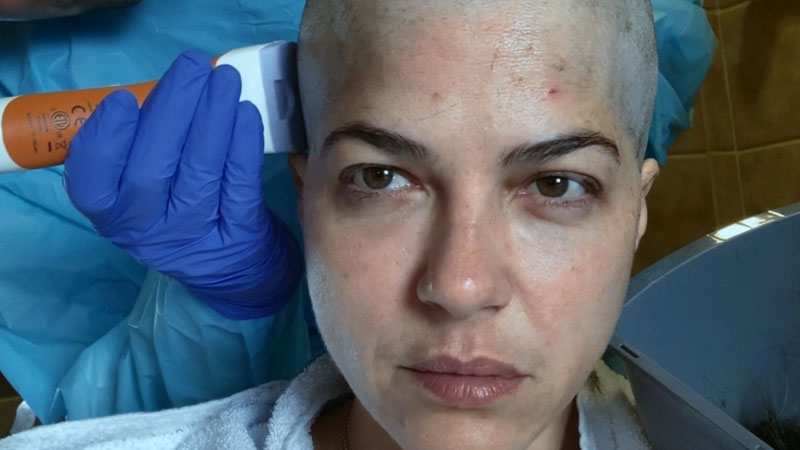Introducing, Selma Blair: A decade since my MS diagnosis, it’s tough to see this documentary on her treatment

Selma Blair undergoes chemotherapy and stem-cell therapy to try and mitigate some of the effects of MS
It could be considered a cliché to refer to a documentary as “unflinching”. It’s how The New York Times describes Introducing, Selma Blair, an account of the actress’s experience with multiple sclerosis (MS), and her journey through aggressive stem-cell therapy in an attempt to manage her condition.
It’s no exaggeration to say that I flinched. It took me several attempts to watch the 90-minute film, not because the material was dull or plodding, but because it felt so raw, shocking, and scary. Blair is a powerhouse, deliciously eccentric and caustically funny, channeling Joan Crawford as she preens in an array of jeweled turbans.
Top of Form
For the first 10 minutes or so of the documentary, she is shown tackling her illness with dark humor, going full vaudeville with her cane in hand (“It’s a really cool prop”). But I have to pause the film as I watch her body begin to tic and spasm on camera, her speech slurring – this is no joke.
I’m affected for a number of reasons – not least because it’s exactly a decade since I began experiencing the symptoms that would lead to my own MS diagnosis. I’m 10 years younger than 49-year-old Blair, and it’s frightening to see the full effects of MS being portrayed in this way, somehow even more so in a familiar “Hollywood” figure.
But while I feel fear, I also feel shame. What right do I have to bang on about my condition in comparison? It’s like someone who had a mild version of Covid-19 and spent a day snuffling in bed talking about their trauma while others have been on ventilators or in comas.
I’m one of the lucky ones
Because I’m one of the lucky ones. Diagnosed relatively early, aged 30, with relapsing-remitting MS (a far milder form than Blair’s), I was swiftly put on disease-modifying therapies, which are designed to minimize the chance of relapse and hopefully delay any disability.
The limp that I experienced at the time of diagnosis disappeared as my flare-up went into remission, my legs began to feel like they belonged to my body again, and I took up yoga and weight training to improve my balance, core strength, and flexibility.
While at the time I feared the worst, I didn’t possibly dare dream that a decade on, I would be hale and hearty, working, traveling, and living life to the full.
That’s not strictly true – of course, you dare to dream. When I was diagnosed someone told me (I can’t remember who, perhaps a nurse or a doctor, or maybe I read it in the reams of literature or online) that if I could make it a decade or so without a major “clinical incident” or relapse, I might be considered as having “benign MS”, and could stop using medication. Almost as if I have got away with it.
I was reminded of this recently when my friend (who had held my hand through much of the diagnostic process) asked me if that important anniversary was approaching.
But as with so many of these things, the goalposts appear to have moved. Nowadays, the thinking is that even if you have gone 15 years without a major MS attack, it doesn’t mean you won’t go on to have a relapse or progression of the disease.
The MS Society cautions that the term isn’t recommended: “as it can only describe your past experience of MS, not whether you might relapse in the future”.
Still, though, I am hopeful. I know I’m so lucky that so far I have “got away with it”, and the only real symptoms I feel are fatigue and the occasional ghost of my old leg numbness when I’m run down. Year after year, I breathe a sigh of relief as my MRI scans come back clear, and my neurology appointments are short and sweet.
But my diagnosis spurred me to focus on my health more than I ever had before – like so many of us, we all think we’re invincible in our twenties until a major health incident reminds us not to take our bodies and well-being for granted.
Stronger and kinder
I think it also changed my outlook on life, made me appreciate the little things – going for a run on a cold, sunny morning, traveling to a new destination, being the long-suffering horsey for my increasingly heavy nieces, and nephews, dancing, kisses, cuddles. It made me stronger but softer, kinder, I hope.
Blair is hopeful too, and that warms my heart. Even when she is going through the traumatic experience of stem-cell therapy, which in early trials had a 7 percent mortality rate and involves chemotherapy and a wiped-out immune system, she still cuts a dash with her cane, striking poses and assuming characters.
When she is reunited with her son after her time in isolation in hospital, it is clearly a moment of pure happiness and love for her.
When I was diagnosed, I felt like I didn’t have any role models in the public eye to whom I could relate. It’s remarkable that Selma Blair has had the courage and generosity to share her experience, from her defiant glamour in her Instagram posts to this deeply personal documentary.
I don’t doubt that anyone newly diagnosed who is watching the film will flinch, but I think it’s important for them to know that MS is a broad umbrella, with lots of different outcomes.
Which is why, yes, I’m banging on about my own condition here. And whatever the outcome for me, there is hope, love, and life. Blair says in the documentary: “When I feel better, I really do hope to be a better person.” So do I.


